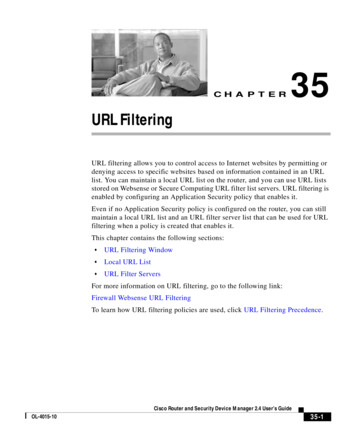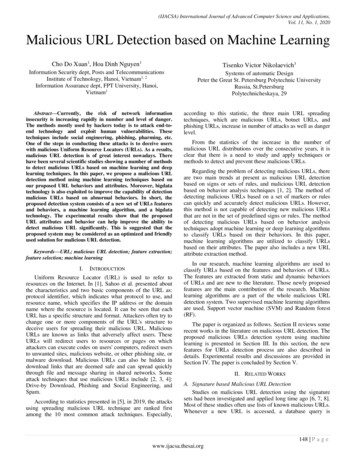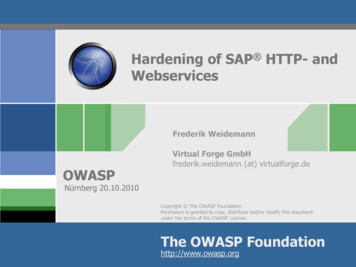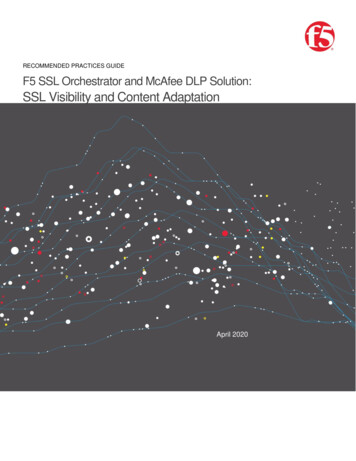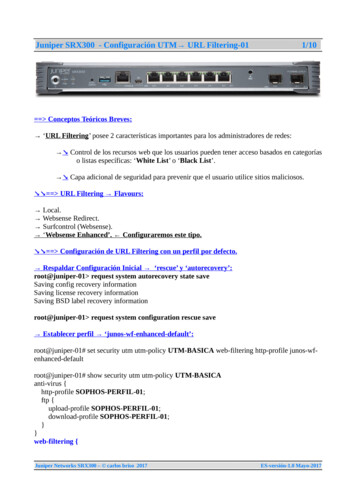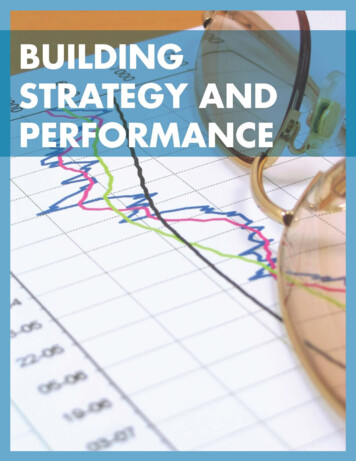
Transcription
This text was adapted by The Saylor Foundation under a CreativeCommons Attribution-NonCommercial-ShareAlike 3.0 License withoutattribution as requested by the work’s original creator or licensee.Saylor URL: http://www.saylor.org/booksSaylor.org2
IntroductionThe defining challenge facing business leaders is to develop and drive performance into the future.For commercial firms, this generally means building profits and growing the value of the business.Although their focus may be on nonfinancial outcomes, public services, voluntary groups, and othernot-for-profit organizations share the same central challenge—continually improving theirperformance. When the causes of performance through time are not understood, management hasdifficulty making the right decisions about important issues. Worse, entire organizations are led intoill-chosen strategies for their future.To overcome these problems, leaders need the means to answer three basic questions:1.Why is business performance following its current path?2. Where are current policies, decisions, and strategy leading us?3. How can future prospects be improved?These questions are the starting point for this book.The key to achieving business success is the ability to develop and sustain critical resources andcapabilities, leveraging what we have today to grow more of what we will need tomorrow. This bookexplains the journey your organization takes through time as it builds this portfolio of vital resources.It provides innovative ideas that enable readers to answer the three questions and develop asustainable winning strategy.The approach described here is based on strategy dynamics (Warren, 2008), a rigorous, fact-basedmethod for developing and managing strategy. The underlying science is known as system dynamics,which originated at the Massachusetts Institute of Technology in the 1960s (Forrester, 1961;Sterman, 2000). Strategy dynamics explain why the performance of an organization has changedthrough time in the way that it has, provide estimates of where it is likely to go in the future, andallow management to design strategies and policies to improve that future path. Strategy dynamicsachieve this by building an integrated, fact-based picture of how the resources of your business aredeveloping through time, driven by mutual interdependence, management policies, externalopportunities, and constraints.Saylor URL: http://www.saylor.org/booksSaylor.org3
This book has been written in a compact and easy-to-read style to help managers quickly understandthe underlying causes of strategic challenges so that they can take action to improve performance. Ituses clear examples to show how things can go well if managers have a firm grasp of the changingresources in their business, or badly if this perspective is missing. It describes practical techniquesfor developing a dynamic, time-based picture of a range of challenges. It includes a clear overview at the start of each chapter setting out the issues and techniques to beexplained; action checklists highlighting practical considerations to help ensure that the approach is appliedsuccessfully; worked examples, diagrams, and tips on doing it right, showing how the techniques andideas can be implemented to uncover new insights and benefit your entire organization.Traveling the critical path to organizational success is a challenging and fascinating journey. Thisbook provides a practical, in-depth guide to help you along the way. If you would like to understandand discuss these techniques in more detail, I would be delighted to hear from youathttp://www.strategydynamics.com/ or visit to my blog athttp://www.kimwarren.com.Saylor URL: http://www.saylor.org/booksSaylor.org4
Chapter 1Performance Through TimeOverviewThe biggest challenge facing business leaders is to understand and drive performance into the futurewhile improving long-term profits. Executives in nonprofit organizations have performance aims too,though they may not be financial. To tackle this challenge, leaders need good answers to three basicquestions: why the business’s performance is following its current path, where current policies andstrategy will lead, and how the future can be altered for the better.This chapter will do the following: clarify these questions and explain the contribution that a sound approach to strategy can make explain why performance through time is so critical outline some limitations of existing strategy tools that explain why few senior managers usethem give you practical techniques for developing a time-based picture of the challenges you face1.1 The Challenge for Business LeadersYour organization’s history is fundamental to its future. What you can achieve tomorrow depends onwhat you have today, and what you have today is the total of everything you have built up, and heldon to, in the past. This is true even for new ventures when the entrepreneur brings experience,credibility, and contacts to bear on creating the new business.It also holds true for nonprofit activities: voluntary groups, government services, andnongovernmental organizations (NGOs). They too can only achieve what is possible with theircurrent resources, and if more resources are needed then existing ones must be used to get them. Acharity will not appeal to many new donors, for example, unless it has built a reputation.When the causes of performance through time are not understood, organizations make poor choicesabout their future. They embark on plans they cannot achieve and fail to assemble what they need inSaylor URL: http://www.saylor.org/booksSaylor.org5
order to achieve even those plans that might be feasible. The catalog of failed initiatives, in everysector and through all time, would make a thick book indeed. These failures are costly not only inmoney but also in terms of wasted and damaged human potential. The better news is thatorganizations are often capable of far more than they imagine, if only they choose objectives well andpiece together the necessary elements.Improving an organization’s performance is not just a matter for top management. Given the righttools, everyone with influence over the way in which any part of their enterprise functions can makea difference. Challenges may be focused on an individual department or span the whole organization;they may range from very small to truly huge; and they may call for urgent measures or a long-termapproach. This book focuses on the content of strategy—what the strategy actually is—in contrast tothe equally important issues of the process by which strategy happens in organizations (Mintzberg,Lampel, Quinn, & Ghoshal, 1997).1.2 The Importance of TimeThe following cases illustrate organization-wide challenges with long-term implications but short-termimperatives for action. The scale of each issue is important, and the cases highlight the time path overwhich strategic challenges evolve and resources develop or decline. Ensuring that these changes play outat the right speed is vital.The starting point for the approach that we will develop in later chapters is shown in Figure 1.1"Alibaba.com Growth and Alternative Futures".These time charts display three important characteristics:1.A numerical scale (registered users, revenues)2. A time scale (7 years of history to 2007)3. The time path (how the situation changes over that time scale)Saylor URL: http://www.saylor.org/booksSaylor.org6
Figure 1.1 Alibaba.com Growth and Alternative FuturesCase Example: Alibaba.comWe are used to thinking of the goliaths of the Internet age, such as Google, Amazon, and eBay, asunassailable leaders in their fields, but Chinese upstart Alibaba.com showed that eBay, for one, could bebeaten to a massive opportunity, given a careful focus.From the most humble resources—just 60,000 in capital and 18 poorly paid colleagues—the founder,Jack Ma, laid out a vision for what Alibaba could become. Although highly speculative, the vision wassufficiently promising to attract venture funding and some big-name advisers to his board.The business focused on helping smaller Chinese firms that wanted to grow business globally but foundexisting options to be too expensive. The key proposition was to connect such companies to similarlysmall and midsized buyers around the world. In spite of the apparent potential and easier access to largerfirms, Alibaba maintained this focus on small and medium-size enterprises (SMEs). It also stuck tooffering the simple service of connecting buyers and sellers rather than getting involved in othercomplementary activities.A critical issue right at the start was to get sellers and buyers to sign up. Not only did this mean offeringthe core service at no charge but also dealing with the fear of technology among this segment of targetusers by making the Web site ultra-simple to use. In 2000, the company started selling advertising spaceand research reports on its sellers, but revenues were still tiny, at just 1 million, and no profits werebeing made.Saylor URL: http://www.saylor.org/booksSaylor.org7
In 2001, Alibaba started charging for its services, though still at a low rate of 3,000 per year. However,by this time the service’s visibility and reputation were so strong that membership kept on climbing,passing the 1 million mark in 2002.From this focused start, the company was able to extend its activities in several directions, firstestablishing a within-China service in the local language and then making a major thrust to developbusiness-to-consumer (B2C) and consumer-to-consumer (C2C) services. By 2007 the group was serving24 million users and had effectively sealed victory over eBay, which exited the market.These three features ensure that the charts provide a clear view of the challenge, and allow further detailsto be added later. This particular example happens to focus directly on a critical resource—registeredusers—and clarifies the absolute numbers: much more useful than derived ratios such as market share orabstract notions such as competitive advantage. Often, management’s concern will be directed at thefinancial consequences—in other words, revenues and profits.Understanding the history of decisions that have already been made is essential, as they are driving thebusiness’s trajectory into the future. Past additions to the services offered and to the customer groupstargeted brought the business to its state in 2007. Success or failure in the company’s future choices onthese and other issues will determine its trajectory forward from that point in time.Figure 1.2 "Alternative Futures for Blockbuster Inc." shows preferred and feared futures for Blockbuster.Even with the best fortune and skilled management, the company will do well to sustain revenues andremain profitable, and it is hard to see how it might avoid closing more stores. Services such as Netflix arenot the only threat—by 2008, increases in communications speed and data processing power were finallymaking the fully online delivery of movies and other content a practical reality. This threatened a stillfaster decline in store-based rental income. Note, by the way, that for Blockbuster to engage in onlinedelivery of movies does not remove the challenge that this innovation creates for its stores and postalbusiness. Even if it were successful in that initiative, someone would still have the challenge of managingthe declining revenue from renting physical DVDs and finding ways to keep it profitable. Any profits fromonline delivery would be in addition to what is shown in Figure 1.2 "Alternative Futures for BlockbusterInc.".Saylor URL: http://www.saylor.org/booksSaylor.org8
Figure 1.2 Alternative Futures for Blockbuster Inc.Case Example: Blockbuster Inc.Not all strategic challenges are so happily able to focus on sustaining spectacular growth in businessactivity and financial rewards. Other cases pose substantial threats, where the best that strategicmanagement may be able to achieve is to resist decline or even closure.Blockbuster Inc., from its startup and early growth in the late 1980s, effectively defined and dominatedthe market for renting movies to watch at home. Up to 1995, sales and profits climbed ever upward,driven by aggressive expansion of the company’s store network, both owned and franchised, voraciousacquisition of smaller chains, and entry into many new country markets. From 1995, it proved hard tosustain profitability, and by 2000 pressures on revenues and profits escalated sharply with the launch ofNetflix.com, a service that allowed consumers to order movies on the Internet for postal delivery andreturn. With the new convenience this offered consumers, and without the costly burden of store realestate and staff, Netflix was able to offer very attractive prices and soon started to steal consumers fromBlockbuster.Soon other providers such as Amazon offered a similar service, and Blockbuster found itself fighting forits life. It had no choice but to offer a comparable postal service, adding to the erosion of store revenues inSaylor URL: http://www.saylor.org/booksSaylor.org9
spite of the company’s best efforts to make a positive advantage of the combined channels. As revenuessuffered, marginal stores began to lose money, and closures became inevitable.1.3 Problems With Existing Strategy ToolsGiven that the problem of managing performance through time is universal, it is astonishing that timecharts like those in our exhibits are almost completely absent from business books and managementliterature. Try looking for yourself next time you find yourself in a business bookstore. So what tools domanagers actually use to help them decide what to do?A regular survey by one of the large strategy consulting firms identifies a long list of management tools(Bain & Company, 2007). However, few of these have won much confidence among managers, with theresult that they come and go in popularity like fashions in clothing. The tools fall into several categories: simple principles open to wide interpretation, such as vision statements and strategic planning substantial changes to business configurations, such as reengineering and outsourcing approaches to controlling performance, such as value-based management and the balanced scorecard problem-solving methods, such as the five forces, real options, and customer segmentationA wide-ranging study by another consulting company, McKinsey (Coyne & Subramanian, 2000), foundthat there were few strategy tools with sound methodological foundations beyond the industry forces andvalue-chain approaches set out by Michael Porter in the early 1980s (Porter, 1980). The many qualitativemethods available seemed to work well only in the hands of their developers and were limited in theirability to provide robust, fact-based analysis.To understand the potential value of a sound approach to managing performance through time, it is usefulto start by identifying the problems with current approaches to strategy.SWOT AnalysisAssessing an organization’s strengths, weaknesses, opportunities, and threats (SWOT) is a method widelyused by managers to evaluate their strategy. Unfortunately, it offers little help in answering thequantitative questions illustrated in Figure 1.1 "Alibaba.com Growth and Alternative Futures" and Figure1.2 "Alternative Futures for Blockbuster Inc.". Typically, the concepts are ambiguous, qualitative, and factfree. Discovering that we have the strength of great products and an opportunity for strong market growthSaylor URL: http://www.saylor.org/booksSaylor.org10
offers us no help whatsoever in deciding what to do, when, and how much to bring about what rate oflikely growth in profits.Opportunities and threats are features of the external environment; as such, they are better dealt with byconsidering industry forces and political, economic, social, and technological (PEST) analysis (see Chapter4 "Handling Interdependence Between Resources"). Strengths and weaknesses, on the other hand, centeron the firm itself, so they are related to the resource-based view (RBV) of strategic management.RBV writers generally devote attention to more intangible resources and the capabilities of organizationson the assumption that tangible factors are easy for competitors to copy and therefore cannot provide thebasis for competitive advantage (Barney, 2006; Collis & Montgomery, 1994). Later chapters will show,however, that performance cannot be explained or improved without a strong understanding of howsimple resources behave, both alone and in combination, and how they are controlled. Our two examplesalready illustrate common types of tangible and intangible factors that may need to be taken into account(Table 1.1 "Examples of Resources in Alibaba.com and Blockbuster Inc.").Industry Analysis and StrategyThe analysis of competitive conditions within an industry has dominated efforts to understand anddevelop firm performance. In summary, this approach says the following:Table 1.1 Examples of Resources in Alibaba.com and Blockbuster Inc.Alibaba.comBlockbuster Inc.BuyersCustomersSellersStoresRange of ServicesRange of DVDsWeb Site PagesFranchisesReputation Among Users Reputation Among ConsumersSaylor URL: http://www.saylor.org/booksSaylor.org11
We try to make profits by offering products for which customers will pay us more than the productscost us to provide. The more powerful our customers are, the more they can force us to cut prices, reducing ourprofitability. The more powerful our suppliers are, the more they can charge us for the inputs we need, againreducing our profitability. If we do manage to make profits, our success will attract the efforts of competitors, new entrants, andproviders of substitutes, who will all try to take business away from us, yet again depressing ourprofitability.These five forces—buyers, suppliers, rivals, new entrants, and substitutes—thus explain something ofindustries’ ability to sustain profitability through time.The impact of Netflix on Blockbuster is a classic example of the five forces at work, made possible by theincreasing availability and usage of the Internet. The arrival of Netflix allowed consumers to switch to itslower price service from Blockbuster.In other markets too, e-businesses can offer valuable products at very low cost by eliminating substantialcosts associated with conventional supply chains, resulting in attractive profit margins. Buyers face fewswitching costs in taking up these alternatives. By getting very big very fast, the new providers establishbuying power over their own suppliers and erect barriers against would-be rivals. The establishedsuppliers are the substitutes, whose brick-and-mortar assets weigh them down and prevent them fromcompeting in the new business model.Unfortunately, the five forces framework also describes quite neatly why most such initiatives aredoomed. Buyers who are able to switch to the new offering face very low barriers to switching among thehost of hopeful new providers, and do so for the slightest financial incentive. The new business model isoften transparent, requiring little investment in assets, so rivals and new entrants can quickly copy theoffering. Worst of all, many enterprises see the same opportunity for the same high returns from the samebusiness models, so there is a rush of new entrants. Anticipating hefty future profits, many give awaymore than the margin they ever expected to make, in the hope that, as the last survivor, they will be ableto recapture margin in later years.Saylor URL: http://www.saylor.org/booksSaylor.org12
We saw the five forces at work again in the fiasco of the subprime lending boom of 2003–2007 thatbrought the world’s banking system to its knees. Someone spotted the opportunity to lend money forhome purchases to people whose income levels or credit ratings were low. A fraction of these borrowerswould likely default on these mortgages, but that was OK because the much higher interest that wascharged to these borrowers would give sufficient income to cover those losses and more.There was no way to keep this new business opportunity a secret, and nothing about it was hard for bankafter bank to copy. New entrants to the market intensified competition, but in this case rivalry took theform not of lower prices but acceptance of increasingly risky customers. Ultimately, the total rate ofdefaults experienced by the subprime mortgage providers was not sufficiently covered by the high interestrates charged, and profitability collapsed. This whole sorry episode was made worse by banks’ packagingup of these toxic debts and selling them on to other institutions that did not appreciate the true risk, butfundamentally the whole edifice was built on appallingly bad strategic management.It Is the Time Path That MattersAt first glance, the industry forces view makes a lot of sense, and there is indeed some tendency forindustries with powerful pressure from these five forces to be less profitable than others where the forcesare weaker. The implication is somewhat fatalistic: If industry conditions dominate your likelyperformance, then once you have chosen your industry, your destiny is fixed. However, research hasfound that industry conditions explain only a small fraction of profitability differences between firms(McGahan & Porter, 1997). It turns out that factors to do with the business itself are far more importantdrivers of performance.Management does matter: You can be successful in intensely competitive industries or unsuccessful inattractive industries. Moreover, the passive industry forces view takes no account of a firm’s ability tocreate the industry conditions that it wants. In essence, the world is the way it is today because Microsoft,Wal-Mart, Ryanair, and many other firms have made it like this, not because market growth and industryconditions have been handed down from on high.The competitive forces view places great importance on the concept of barriers that prevent industryparticipants (the competitors themselves plus customers, suppliers, and others) from entering, switching,exiting, and making other strategic moves. This implies that these barriers are absolute obstacles: If youSaylor URL: http://www.saylor.org/booksSaylor.org13
can clear them, you are “in”; if not, you are “out.” But business life is not like that. Many industriesinclude small firms operating quite nicely with only a little of the necessary resources, while larger firmsoperate from a more substantial resource base. In fact, barriers to entry do not seem like barriers at all;they are more like hills. If you are a little way up these hills, you can participate to some degree, and thefurther up you are, the more strongly you can compete.So why are strategy tools so weak at answering the basic question of what is driving performance throughtime? It turns out that most strategy research is based on analyzing possible explanations for profitabilitymeasures, such as return on sales or return on assets. Recently, more sophisticated and appropriatemeasures have been used, such as returns based on economic profit (profit minus the cost of capitalrequired to deliver that profit). Typically, data are collected for large samples of firms and plausibleexplanations for performance differences among the sample are tested using statistical regressionmethods.Such studies generate an estimate of how much of the variation in the profitability of different firms isexplained by the suggested causes. These may be external factors such as competitive intensity, or internalfactors such as technology or staff training. Unfortunately, today’s profitability ratios are a very poor guideto future earnings and of little interest to investors. Would you, for example, prefer to have 1,000invested in a firm making 20% margins but with declining revenue or in another firm making 15% butdoubling in size every year?What About Nonbusiness Settings?The last main criticism that can be leveled against existing strategy methods is that they have little to offerthe large number of managers who run organizations that are not primarily concerned with makingprofits. Public services in many economies have been made quasi-commercial in recent years throughprivatization, outsourcing, and other structural changes. Nevertheless, substantial fractions of alldeveloped economies are still accounted for by public services. Charities, NGOs, security services, andother organizations also have objectives to pursue and resources with which to pursue them.Current strategy methods are of little help to such organizations, being almost exclusively built oneconomic analysis of competitive markets. Yet there is a remarkable similarity between the challengesfaced by managers in business and nonbusiness settings (Figure 1.3 "Performance Questions inSaylor URL: http://www.saylor.org/booksSaylor.org14
Commercial and Noncommercial Settings"). In all cases, they are expected to have sound answers to threekey questions:1.Why is our performance following its current path?2. Where is it going if we carry on as we are?3. How can we design a robust strategy that will radically improve this performance into the future?Figure 1.3 Performance Questions in Commercial and Noncommercial SettingsCase Example: RyanairAn example of the failure of conventional industry analysis—and a testament to the success of a resourcebased approach pursued over time—is provided by Ryanair. This low-cost airline operates a businessmodel similar to that of Southwest Airlines in the United States. Its success came at a time when theglobal airline industry faced increased costs combined with static or declining passenger numbers. Therewas sympathy for the comment from Richard Branson of Virgin that “the safest way to become amillionaire is to start as a billionaire and invest in the airline industry.”Ryanair, like Southwest before it, and easy Jet, another budget European operator, challenged theindustry situation when it started offering short-haul flights from Ireland’s Dublin airport in 1995. Theairline focused on creating an ultra-efficient operating system, allowing fares way below existing levels inthe market and maintaining high levels of customer satisfaction. So dramatic were the low levels of faresthat awareness among the public increased rapidly.Saylor URL: http://www.saylor.org/booksSaylor.org15
Ryanair’s success built on the business model originally developed by Southwest, with one type of aircraft(Boeing 737), short-haul travel, no in-flight meals, and rapid turnaround times resulting in aircraftutilization up to 50% greater than the industry average. Ryanair took this approach further, avoidingtravel agents, not issuing tickets, selling food and drink on the plane, and building sales through theInternet. These measures developed and reinforced the strategic priorities of efficiency, awareness, andcustomer satisfaction, and made the airline popular, distinctive, and successful in a fiercely competitivemarket.In a sector where intense competitive forces have made the global industry endemically unprofitable fordecades, Ryanair, easy Jet, Southwest, and a few other determined players have managed to do very nicelyindeed.1.4 Diagnosing PerformanceA simple example helps to explain how this process of understanding, predicting, and improvingperformance works in practice. We will start it here and develop it in later chapters.You find yourself in charge of a restaurant in a medium-size town that gets most of its business fromregular customers. You also win a few new customers from time to time, some of whom becomeregulars. You have had a frustrating time over the past 12 months, as Figure 1.4 "RestaurantPerformance Example" shows.As the year started, you were selling 4,000 meals per month and making profits of 18,000 permonth. Business and profits increased slowly for a few months, then seemed to reach a limit, so inmonth 6 you carried out some marketing, hence the decrease in profits and the increase in mealssold. However, meals sold per month soon reached a new limit, so profits also plateaued. In the lastmonths of the year, you cut your marketing spending, saving money and increasing profits sharply,but at the cost of a decrease in meals sold. This kind of account is what we mean by focusing onSaylor URL: http://www.saylor.org/booksSaylor.org16
performance through time: We are not just concerned with static performance measures such asmarket share, profit margins, or return on capital.Valuing PerformanceFigure 1.4 Restaurant Performance ExamplesA particularly important reason for understanding performance through time is to put a value on firms.Essentially, investors hope to see a strong, increasing stream of “free cash flow”: the cash that is generatedafter reinvesting what is needed to deliver that growth. Free cash flow isOperating income Depreciation – Tax payments Non-operating income – Net investments incurrent assets.Because investors prefer money sooner rather than later, the forecast free cash flows are discounted backto give a “present value,” whether for the firm as a whole or for an investment it intends to make. Howthese measures are calculated and the method of valuation are explained in detail elsewhere (Copeland,Koller, & Murrin, 2000), so from now on we will simply discuss earnings, profits, or operating income.We will assume that finance professionals can do the necessary translation into the correct financialmeasures.The methods used by the finance and investment communities to assess the value of firms and theirstrategic initiatives are exceedingly rigorous and analytical. Regrettably, though, this rigor is applied toflawed models of how businesses function and speculative estimates of the future. It is during theforecasting stage that financial evaluations lose touch with a firm’s strategic reality. A typical approach isto estimat
questions: why the business's performance is following its current path, where current policies and strategy will lead, and how the future can be altered for the better. This chapter will do the following: clarify these questions and explain the contribution that a sound approach to strategy can make
